Into the Woods
Wednesday, November 15, 2017
Number: 54
For that reason, the Army Land Force (FUTER in Spanish) designated it as the referring combat unit in forest, and it was entrusted with the organization of the second updated days in this branch. These days were developed from the 22nd to the 29th of September at the Maneuvers and Shooting Field of Parga (Lugo), where many units of the whole FUTER have participated. The 7th Brigade already had experience on these kind of days because in September of 2016 leaded other days similar to these ones, but, in that occasion, only with the presence of units belonging to Light Forces.
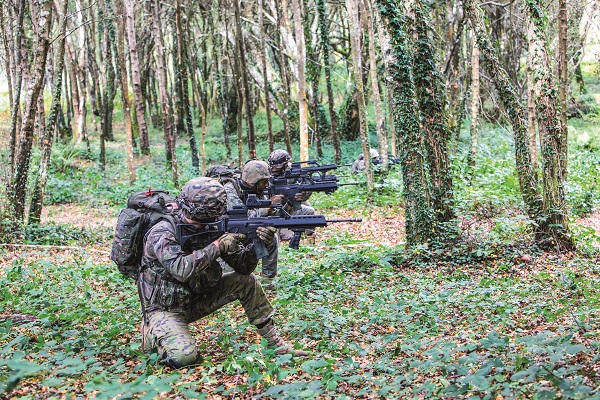 Combat in wooded environment. Photo: Angel Tejedor (DECET)
Combat in wooded environment. Photo: Angel Tejedor (DECET)
In order to prepare this new course, more ambitious, and that has had the presence of observers from Italy and United Kingdom, the 1st Company of the 1/29th Battalion “Zamora” conducted two previous exercises –Company-level type– in that same maneuvers field. They were also visited by the Infantry Battle School in Brecon, Wales, which attended to the Fighting in Woods and Forests (FIWAF) phase, belonging to the course of Non-commissioned officers of the British Army. That way they could update the learned lessons and transmitted them to the participants, 32 altogether, coming from all the Brigades and from the Special Operations Command.
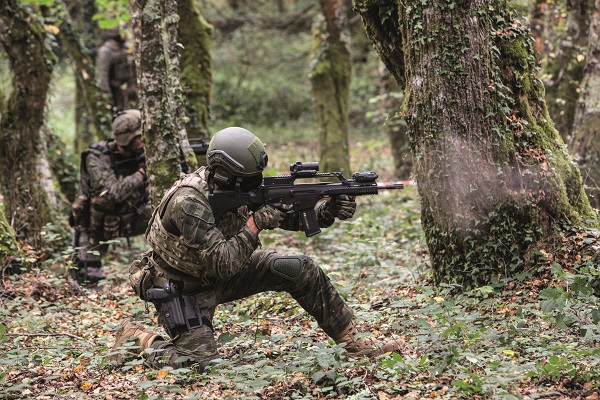 Shooting Exercise in the woods. Photo Ángel Tejedor (DECET)
Shooting Exercise in the woods. Photo Ángel Tejedor (DECET)
Days' Aspects
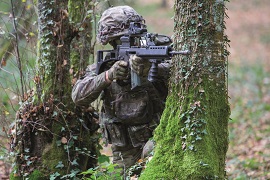
Navegating and hiding in the woods. Photo A. Tejedor (DECET)
Navigating and hiding in the woods. Inside of the course different combat aspects were developed, but with the specific particularities that a wooded environment may present. Lieutenant Ellacuria, the responsible of navigation, is aware of the difficulty that involves guiding inside of a luxuriant growth, where it is difficult to find references, and of the extra physical and psychological exhaustion that entails. However, what he wanted was to make the attendees experiment themselves those feelings at the topographic activities and in the guiding exercises where they participated in, in some cases at night.
Observation post. They also received some instructions in order to place a high observation post, at the top of a tree, only with the help of a rope. “This can be carried out by any rifleman from the Army”, assured Sergeant Surribas to the participants, some of them a little bit skeptical, while he was climbing up the branches of the tree.
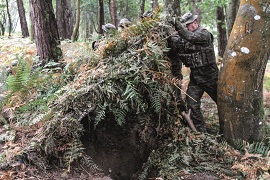
Vigilance Post. Photo: A. Tejedor (DECET)
Survival course. The participants were in a bivouac settled for a squad, where two different types of shelters, an oven for cooking food, a filter for decanting water and a bonfire in the center were established. “We must always keep the fire lighted, and when choosing the place where the bivouac is going to be built, it is very important to settle it next to a water source”, explained the 1st Sergeant Mirás, responsible of the survival area.
Shooting. Identifying the enemy and distinguishing our own people is not the same when dealing with wooded areas in contrast with other stages. That is what Lieutenant Calvo wanted the participants to check; he was the responsible of the shooting practices. For that, he prepared a squad exercise with real fire and the participants, after its performance, they could not do anything but justifying him.
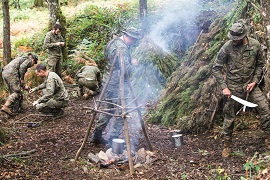
Survival Exercise. Photo A. Tejedor (DECET)
Sanitary Attention. It was also explained the sanitary aspect of wood combat that, as Lieutenant Adarve showed, it has its particularities. The main issue is the evacuation of those who are injured and searching for a route for the ambulances.
ARMY UNITS
- Araba Álava |
- Albacete |
- Alicante |
- Almería |
- Asturias |
- Ávila |
- Badajoz |
- Barcelona |
- Burgos |
- Cáceres |
- Cádiz |
- Cantabria |
- Castellón |
- Ceuta |
- Ciudad Real |
- Córdoba |
- A Coruña |
- Cuenca |
- Girona |
- Granada |
- Guadalajara |
- Gipuzkoa |
- Huelva |
- Huesca |
- Islas Baleares |
- Jaén |
- León |
- Lleida |
- Lugo |
- Madrid |
- Málaga |
- Melilla |
- Murcia |
- Navarra |
- Ourense |
- Palencia |
- Las Palmas |
- Pontevedra |
- La Rioja |
- Salamanca |
- Segovia |
- Sevilla |
- Soria |
- Tarragona |
- Santa Cruz de Tenerife |
- Teruel |
- Toledo |
- Valencia |
- Valladolid |
- Bizkaia |
- Zamora |
- Zaragoza



